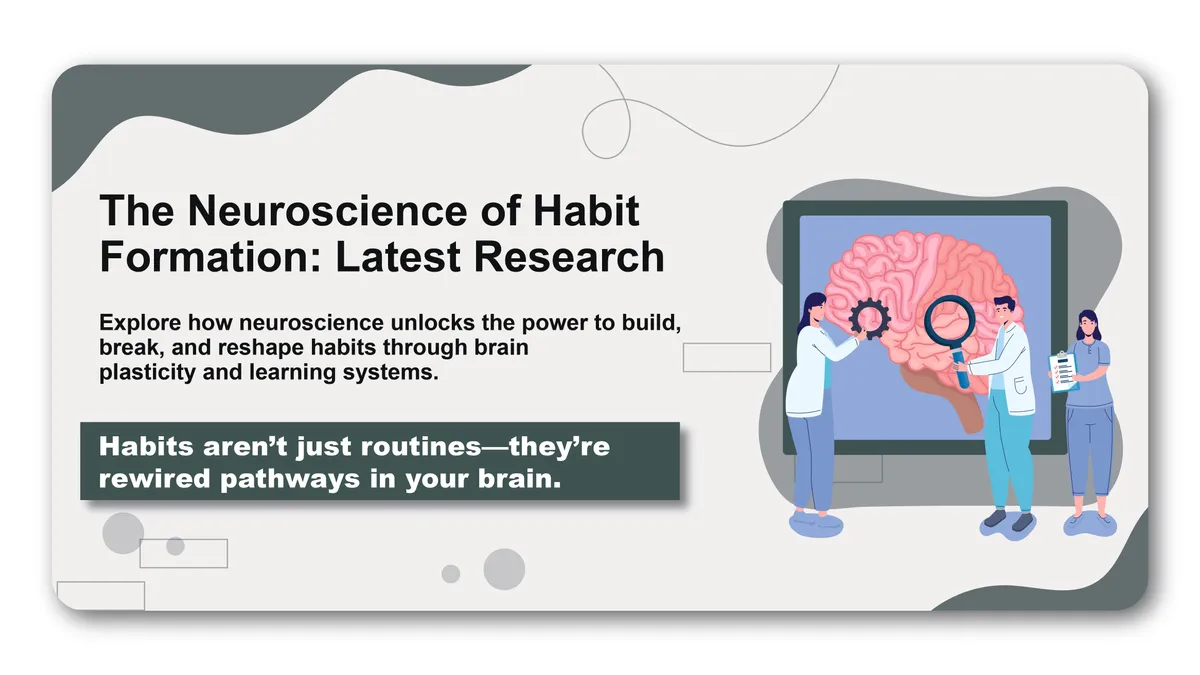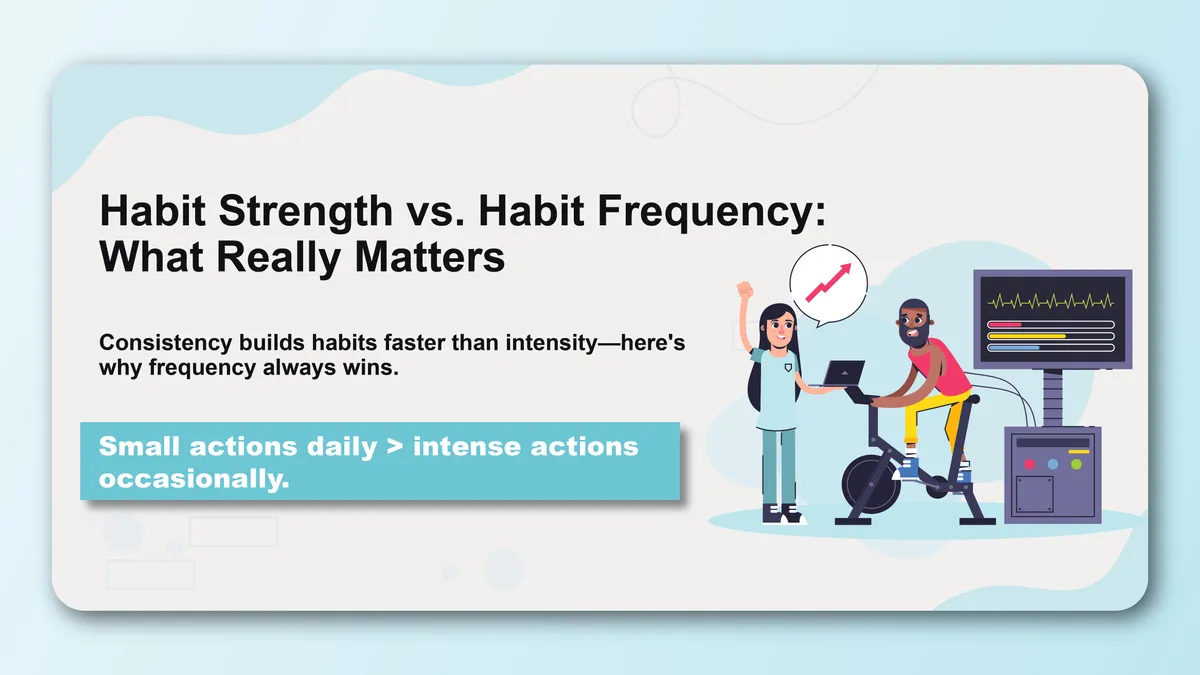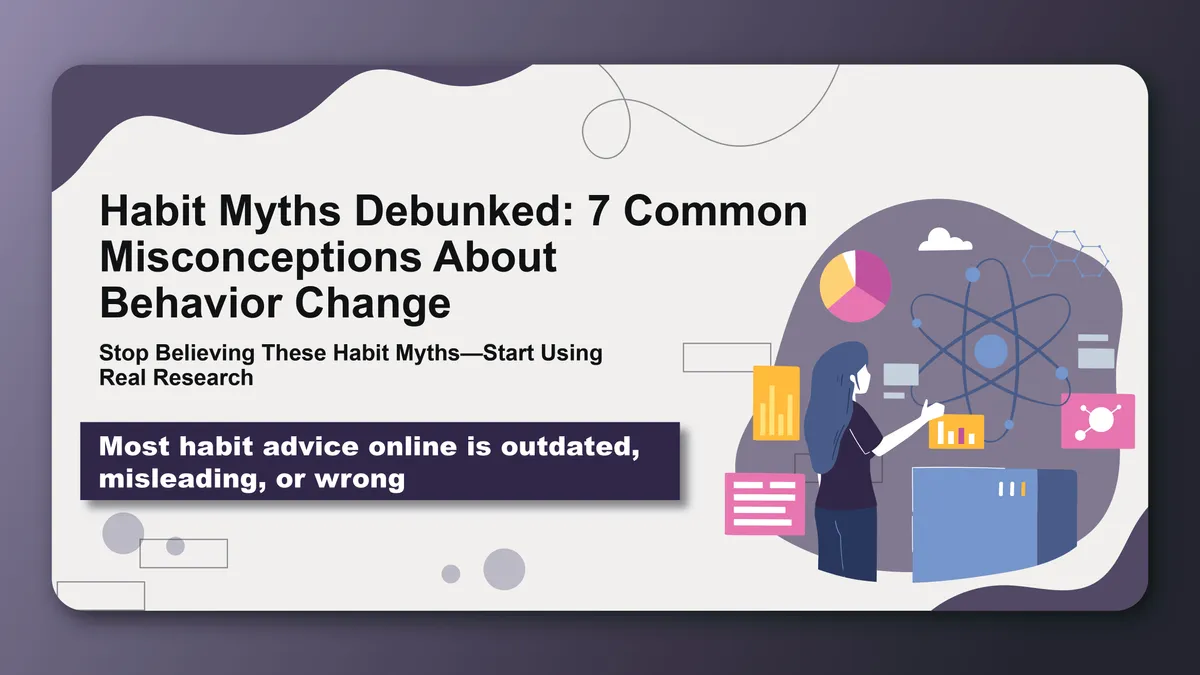"It takes 21 days to form a habit." You've probably heard this claim countless times. It's repeated in self-help books, motivational speeches, and productivity blogs. There's just one problem: it's completely wrong.
The 21-day myth has misled millions of people and caused unnecessary frustration when habits don't stick as quickly as promised. The truth about habit formation timelines is both more complex and more encouraging than the oversimplified 21-day rule.
In this guide, we'll explore the real science behind habit formation timelines, where the 21-day myth came from, and what the research actually tells us about building lasting habits.
The Origin of the 21-Day Myth
Dr. Maxwell Maltz and Plastic Surgery
The 21-day myth traces back to Dr. Maxwell Maltz, a plastic surgeon who wrote the bestselling book "Psycho-Cybernetics" in 1960. Dr. Maltz noticed that his patients took about 21 days to adjust to their new appearance after surgery.
He wrote: "It requires a minimum of about 21 days for an old mental image to dissolve and a new one to jell."
The Problem: Dr. Maltz was talking about adjusting to a new self-image, not forming habits. He also said "minimum of about 21 days"—not exactly 21 days.
How the Myth Spread
Over time, Dr. Maltz's observation was:
- Misinterpreted as applying to all habits
- Simplified from "minimum of about 21 days" to "exactly 21 days"
- Repeated without scientific verification
- Popularized because it sounded achievable and definitive
The myth persisted because people wanted a simple, concrete timeline for change.
The Real Science: Dr. Phillippa Lally's Research
The University College London Study
In 2009, Dr. Phillippa Lally and her team at University College London conducted the first rigorous scientific study on habit formation timelines. They followed 96 participants for 12 weeks as they tried to establish new habits.
Study Design:
- Participants chose one new habit to develop
- Habits ranged from simple (drinking water) to complex (50 sit-ups)
- Daily self-reporting of habit performance
- Measured "automaticity"—how automatic the behavior felt
The 66-Day Average
The study revealed that it took an average of 66 days for a behavior to become automatic. But this average hides important variations:
Key Findings:
- Range: 18 to 254 days (depending on the habit and person)
- Average: 66 days across all participants
- Plateau: Most habits plateaued around 66 days
- Individual variation: Some people formed habits much faster or slower
What "Automatic" Actually Means
The study measured automaticity using several criteria:
- Effortlessness: How little conscious effort was required
- Lack of awareness: How often the behavior occurred without thinking
- Difficulty controlling: How hard it was to stop the behavior
- Mental efficiency: How little mental energy the behavior consumed
Factors That Influence Habit Formation Speed
1. Habit Complexity
Simple Habits (18-30 days):
- Drinking a glass of water after waking up
- Taking vitamins with breakfast
- Putting on a seatbelt
- Checking your phone when it buzzes
Moderate Habits (30-90 days):
- Exercising 3 times per week
- Reading for 20 minutes daily
- Meditating for 10 minutes
- Eating a healthy breakfast
Complex Habits (90-250+ days):
- Learning a new language daily
- Mastering a musical instrument
- Developing a comprehensive morning routine
- Building a new exercise program
2. Individual Differences
Personality Factors:
- Conscientiousness: Higher scores = faster habit formation
- Self-discipline: Better self-control = more consistent practice
- Openness: More flexible people adapt to new routines faster
- Neuroticism: Higher anxiety can slow habit formation
Lifestyle Factors:
- Available time: More time = easier habit integration
- Stress levels: High stress slows habit formation
- Social support: Strong support accelerates habit building
- Current habits: Existing routines can help or hinder new ones
3. Environmental Context
Stable Environments (Faster Formation):
- Consistent daily schedule
- Predictable surroundings
- Reliable cues and triggers
- Minimal disruptions
Variable Environments (Slower Formation):
- Changing schedules
- Travel or relocation
- Inconsistent triggers
- Competing priorities
4. Habit Stacking and Triggers
Strong Triggers (Faster Formation):
- Linking to existing habits
- Clear environmental cues
- Consistent timing
- Obvious reminders
Weak Triggers (Slower Formation):
- Vague timing ("sometime today")
- Relying on motivation
- Inconsistent cues
- Complex trigger chains
The Habit Formation Timeline: What to Expect
Days 1-21: The Foundation Phase
What's Happening:
- High conscious effort required
- Frequent forgetting
- Motivation-dependent
- Easy to abandon
What to Expect:
- Inconsistent performance
- Mental fatigue from the effort
- Doubt about the habit's value
- Temptation to quit
Success Strategies:
- Start ridiculously small
- Use strong, consistent triggers
- Track progress daily
- Celebrate small wins
Days 22-66: The Integration Phase
What's Happening:
- Gradual increase in automaticity
- Less conscious effort required
- Habit becomes more stable
- Resistance to change develops
What to Expect:
- More consistent performance
- Occasional missed days
- Habit feels more natural
- Environmental dependencies become clear
Success Strategies:
- Maintain consistency
- Plan for obstacles
- Gradually increase difficulty
- Reinforce with rewards
Days 67+: The Maintenance Phase
What's Happening:
- High automaticity achieved
- Minimal conscious effort
- Habit feels natural
- Strong resistance to change
What to Expect:
- Effortless performance
- Habit maintenance without motivation
- Discomfort when habit is interrupted
- Integration with identity
Success Strategies:
- Allow for natural evolution
- Connect to long-term goals
- Maintain environmental supports
- Share success with others
Why the Real Timeline Is Actually Good News
Realistic Expectations
Understanding the real timeline helps you:
- Set realistic goals: 66 days, not 21
- Prepare for challenges: Expect ups and downs
- Avoid premature quitting: Persist through difficult phases
- Plan adequate support: Ensure long-term success
The Plateau Effect
Research shows that habit strength increases rapidly at first, then plateaus. This means:
- Early progress: You'll see quick initial improvements
- Diminishing returns: Progress slows but continues
- Eventual mastery: Habits become truly automatic
- Maintenance mode: Less effort required long-term
Individual Variation Is Normal
The wide range (18-254 days) means:
- Some habits form quickly: Simple habits can stick in weeks
- Others take longer: Complex habits need more time
- You're not failing: Slow progress is still progress
- Persistence pays off: Consistency matters more than speed
Common Misconceptions About Habit Timelines
Myth 1: "All Habits Take the Same Time"
Reality: Different habits have vastly different formation times. Drinking water is easier than learning to code.
Myth 2: "If It's Not Automatic by Day 21, It's Not Working"
Reality: Most habits are just getting started at day 21. The real work happens in weeks 4-10.
Myth 3: "Missing One Day Ruins Everything"
Reality: Occasional missed days don't significantly impact habit formation. Consistency matters more than perfection.
Myth 4: "Once Formed, Habits Are Permanent"
Reality: Habits can weaken without practice and strengthen with reinforcement. They require ongoing (minimal) maintenance.
Myth 5: "You Should Feel Motivated Throughout the Process"
Reality: Motivation fades. Successful habit formation relies on systems, not feelings.
How to Use Timeline Knowledge Effectively
Set Appropriate Expectations
For Yourself:
- Commit to at least 10 weeks of practice
- Expect the first 3 weeks to be the hardest
- Plan for motivation to fluctuate
- Celebrate progress, not just outcomes
For Others:
- Share realistic timelines when coaching
- Prepare supporters for the real journey
- Don't promise quick fixes
- Emphasize long-term thinking
Design Your Environment for Success
Week 1-3: Maximum Support
- Remove all barriers
- Create obvious cues
- Minimize competing demands
- Track everything
Week 4-8: Maintain Consistency
- Adjust systems based on experience
- Plan for obstacles
- Reinforce with rewards
- Build habit stacks
Week 9+: Reduce Scaffolding
- Gradually remove supports
- Trust the automatic process
- Focus on identity alignment
- Share your success
The Role of Habit Tracking in Timeline Success
Why Tracking Matters for Timelines
Provides Objective Feedback:
- Shows actual progress vs. perceived progress
- Identifies patterns and obstacles
- Maintains motivation during difficult periods
- Celebrates milestones appropriately
Optimal Tracking Strategies:
- Daily tracking: Record completion immediately
- Weekly reviews: Assess overall progress
- Monthly check-ins: Evaluate system effectiveness
- Quarterly assessments: Plan for habit evolution
Tools for Long-Term Tracking
Simple Methods:
- Calendar with X's for completed days
- Habit journal with daily entries
- Photo documentation of progress
- Accountability partner check-ins
Advanced Methods:
- Habit tracking apps: Automated reminders and analytics
- Comprehensive platforms: Integration with goals and tasks
- Wearable devices: Automatic behavior monitoring
- Data analysis: Pattern recognition and optimization
Practical Applications of Timeline Knowledge
For Habit Beginners
Start with Realistic Expectations:
- Choose one habit to focus on
- Commit to 10 weeks minimum
- Expect challenges in weeks 2-4
- Plan celebration for week 10
Design for Success:
- Make the habit ridiculously small
- Use strong, consistent triggers
- Track progress daily
- Prepare for obstacles
For Habit Veterans
Leverage Your Experience:
- Apply timeline knowledge to new habits
- Help others with realistic expectations
- Build habit systems, not just individual habits
- Share your journey to inspire others
For Habit Coaches
Set Client Expectations:
- Explain the real timeline upfront
- Prepare for the motivation dip
- Celebrate progress milestones
- Adjust expectations based on habit complexity
The Long-Term Perspective
Beyond 66 Days
Habit Evolution:
- Habits continue to strengthen beyond 66 days
- Environmental changes can disrupt even strong habits
- Habits can be modified and improved over time
- Identity integration happens gradually
Maintenance Requirements:
- Minimal ongoing effort required
- Environmental supports remain important
- Occasional reinforcement helps
- Social connections support long-term success
Building Habit Systems
Sequential Habit Building:
- Master one habit before adding another
- Use established habits as anchors for new ones
- Create morning/evening routines
- Build identity through consistent behavior
Habit Stacking Timeline:
- Week 1-10: Establish foundation habit
- Week 11-20: Add connected habit
- Week 21-30: Integrate into routine
- Week 31+: Optimize and expand
Your Habit Timeline Action Plan
Pre-Habit Planning
Before You Start:
- Choose one specific habit
- Estimate formation time based on complexity
- Commit to 10+ weeks of practice
- Design environmental supports
Timeline Milestones
Week 1: Focus on consistency, not perfection Week 3: Expect motivation to dip, rely on systems Week 6: Habit should feel more natural Week 10: Celebrate significant progress Week 15: Enjoy relatively automatic behavior
Long-Term Success
Monthly Reviews:
- Assess habit strength
- Adjust environmental supports
- Plan for upcoming challenges
- Consider habit expansion
Quarterly Planning:
- Evaluate overall progress
- Add new habits if appropriate
- Refine existing systems
- Set new long-term goals
Conclusion: Embrace the Real Timeline
The 21-day myth has done more harm than good, setting unrealistic expectations that lead to frustration and abandonment. The real timeline—an average of 66 days with significant individual variation—is actually empowering because it:
- Sets realistic expectations: No more false promises
- Explains normal struggles: Difficulty is expected, not failure
- Guides proper planning: Adequate time and support
- Celebrates real progress: Genuine milestones worth honoring
Key Takeaways:
- Average is 66 days, but range is 18-254 days
- Complexity matters: Simple habits form faster than complex ones
- Individual differences are normal: Your timeline may vary
- Consistency beats perfection: Keep going despite setbacks
- The journey is worth it: Long-term benefits justify the time investment
Stop chasing the 21-day myth and embrace the real timeline. Your habits—and your long-term success—will thank you.
Ready to build habits with realistic timelines and proven strategies? Start your evidence-based habit journey with Habityzer and track your progress with tools designed for long-term success.



